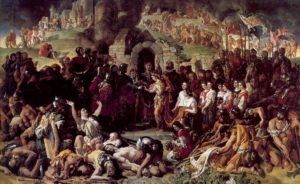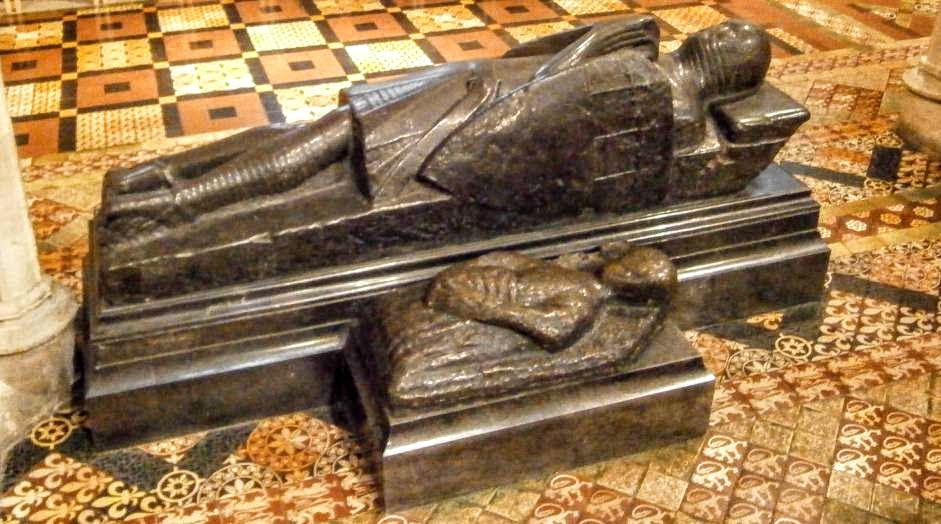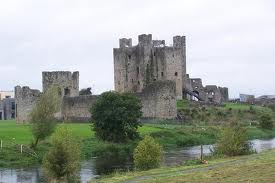Did ‘the Normans’ invade Ireland?

Who were 12th century invaders of Ireland? By John Dorney
Some years ago, at a conference on Dublin’s economic history, I listened to a historian named Sparky Booker speak interestingly about the 15th century freemen of Dublin – that is those with a right to vote for the city’s Aldermen.
Booker noted that medieval Dublin was an English city, with the native Irish having been banished from its walled city limits by an ordinance of 1450 and only ‘those of English birth’ being allowed to become tradesmen and members of the guilds. This annoyed an audience member, who protested that medieval Dubliners were not ‘English’ but, by origins Vikings and laterally, Normans! She did not want to hear them being referred to as ‘English’.
The question of whether the ‘Normans’ or the ‘English’ invaded Ireland in the twelfth century has a surprising degree of emotional baggage.
The speaker was polite and made the fairly unanswerable point that ‘English’ was what the rulers and most of the denizens of medieval Dublin called themselves. And that though some of them may have had other origins, by the 15th century, they saw themselves only as ‘the English of Ireland’.
I wondered what the emotional investment in the ‘Normans’ was in this case. After all, if the traditional narrative of ‘800 years of oppression’ is to hold water, then the medieval English presence must be included. Was it that adopting the Normans, whose names, Fitzgerald, Burke, de Lacy and so on, are now seen as quintessentially ‘Irish’, lessened the shame of long colonisation by the neighbouring country?
Or was it that it simplified Irish history a little? One of the mind-bending contradictions of that history is that the ‘English of Ireland’, including Dublin and ‘the Pale’, found themselves, as Catholics, on the wrong side of the Protestant reformation in the 17th century and effectively changed sides and became integrated into the wider Irish community.
If ‘the Normans’ who first arrived in Ireland in 1169, were not ‘English’ and became ‘more Irish than the Irish themselves’, then the contradiction in Irish historical memory is ironed out a little.
Normans or English?

But were the events of the late 12th century a ‘Norman’ conquest or an English one?
Historians still seem to disagree. At a recent conference in Trinity College Dublin, held to commemorate the 850th anniversary of the invasion of 1169, historian Sean Duffy stated that the conquerors called themselves ‘English’, not Normans.
Medieval historians argue about the terms but most prefer to describe the invaders as ‘English’
He argued that the fashion for styling it a ‘Norman’ conquest goes back only to the 19th century. Colin Veach agreed, stating that the term ‘Normans’ in Irish history came from a wish to associate the island’s story with wider European history.
However, Conor Kostick in his recent book, Strongbow, The Norman Invasion of Ireland, argues for the use of the term ‘Norman’. He argues that the leader of the expedition to Ireland, Richard de Clare (or ‘Strongbow’) and his followers, though settled in England and Wales and not Normandy, had a strong sense of ‘Normanitas’; speaking the French language, fighting in the manner of Norman knights and referring to themselves as ‘Franci’ in distinction to their English and Welsh foot soldiers. Strongbow, he argues was in fact ‘the last of the great adventurers to emerge from the Norman tradition’.
So, what to think? Not being, by any stretch, a historian of medieval Ireland, the following is my attempt to gain some perspective on the matter.
Who were the Normans?

The Normans were originally Scandinavian or ‘Viking’ raiders who settled in the north of France in the 10th century.
Their name derives from ‘northmen’ – a nod to their Scandinavian heritage, though they rapidly adopted a dialect of the French language. The Normans carved out for themselves the Duchy of Normandy, very loosely under the authority of the King of France.
Formidable warriors, adept at mounted warfare and building fortifications, they founded kingdoms as far away from Normandy as Sicily and southern Italy in the 1070s and were heavily involved in fighting the Crusades and in setting up the Christian states in the middle east in the 1090s.
The Normans were descendants of Scandinavians, settled in France, formidable warriors who carved out kingdoms across Europe and beyond.
For our purposes however, the most important date is 1066, when William of Normandy invaded England, defeated and killed its last Saxon King, Harold, and assumed for himself the throne of that country. His aristocratic followers also seized much of England’s best land, with the result that for about 250 years thereafter, the aristocracy and ruling class of England was largely French speaking and of Norman origin.
Richard de Clare, Hugh de Lacy and the other knights who came to Ireland in 1169 and 70 were certainly of this origin.
How did the Normans (or English) come to Ireland?

Richard de Clare or Strongbow was the scion of an important Norman dynasty, who had come to England with William the Conqueror himself in 1066. However by the 1160s, de Clare held relatively poor lands in south Wales and was denied further advancement by the king of England, Henry II, who wished to stop his noblemen from becoming too powerful.
De Clare therefore jumped at the chance of coming to Ireland, at the behest of the King of Leinster Diarmaid MacMurrough (or MacMurchadha).
Ireland at the time was divided into many rival kingdoms, with only notional superiority over the whole island by the High King. MacMurrough had been ousted as King of Leinster, Ireland’s eastern province, by the High King (titular king of all Ireland) Rory O’Connor (Ruairi O Connuchabiar) and King of Breifne Tiernan O’Rourke, and MacMurrough wanted Anglo-Norman military muscle to win it back.
To this end he offered Strongbow the hand of his daughter Aoife in marriage – which opened the prospect of de Clare inheriting lands in Ireland and possibly the Kingdom of Leinster itself.
An advance guard of Anglo Normans arrived near Wexford town in 1169 and Richard de Clare arrived the following year. His forces, which included Anglo-Norman knights, Welsh bowmen and English footsoldiers as well as sprinkling of Flemings, stormed Waterford city and successfully took Dublin from its Irish-Norse inhabitants, after a surprise march through the Wicklow mountains.
Richard de Clare or Strongbow originally came to Irelnad to aid Diarmuid MacMurrough recover the title of King of Leinster.
When Diarmiud MacMurrough died the following year, Richard de Clare proclaimed himself King of Leinster in his stead. However this roused both Diarmuid’s enemies, who also wanted to inherit the kingdom, and some of Diarmuid’s own relatives against ‘Strongbow’. De Clare found himself besieged in Dublin by the High King Rory O’Connor, but in a surprise attack, the Anglo Normans routed O’Connor’s forces at Castleknock and lifted the siege.
It appeared that Strongbow was beginning to win for himself a new kingdom in Ireland, but he was stopped in his tracks by Henry II, King of England, who had no intention of allowing Richard de Clare to establish a rival powerbase across the Irish Sea. Henry landed in Ireland with a large army in 1171 and proclaimed himself Lord of Ireland.
There had been some plans to invade Ireland since the 1150s and there was even a religious justification. It was alleged that the Irish Church had allowed ‘errors’ to creep into its practice and the Pope had granted Henry a ‘Laudabiliter’ for some sort of incursion into Ireland to correct them. This was probably not, modern scholars argue, a mandate to conquer Ireland, as Gerald of Wales, a chronicler of the conquest insisted, but rather permission for a limited intervention to reform the Irish Church.
In any case, establishing Henry’s authority in Ireland proved, in the short term, to be surprisingly easy. Both the Anglo Norman lords such as Strongbow and also the Irish kings submitted to Henry without resistance. The English King left Ireland the following year after granting land to his loyal followers. Hugh de Lacey for instance was granted much of modern County Meath, which he secured by building a huge castle at Trim.
Even the High King Rory O’Connor acknowledged Henry’s overlordship in a treaty of 1175. In the meantime, ambitious Anglo Norman families such as the Fitzgeralds seized rich land in the south of Ireland by force, as did the de Courcey family in the north and the de Burgos or Burkes in the west. The result was that by the mid 13th century much of Ireland was in the hands of Anglo-Norman lords.
This writer’s home village of Rathfarnham in County Dublin was granted to one Milo le Bret, originally, it is thought, of Brittany, France, in the 1190s.
A Norman Conquest?

So was this a ‘Norman’ conquest? Certainly, the elite of the conquerors spoke the French language and not English. This included King Henry II, who came from a dynasty based in Anjou in northern France.
And French continued to be spoken by this ruling class in Ireland for about two hundred years thereafter. A famous literary account of the conquest, The Song of Dermot and the Earl was written in French.
So was a poem about the fortification of the town of New Ross. A 14th century Bishop complained (in Latin) of bawdy songs being sung in French by the townsmen of Kilkenny. Even the Statutes of Kilkenny written in 1366, which were intended to promote the use of English and halt the resurgence of the Irish language, were originally written in French.
The original ‘English’ elite in Ireland were largely French speaking, as a result of their Norman heritage
It was the 1472 before it was proclaimed that English, not French would be the primary language of law and of the state in Ireland. So certainly the medieval colony in Ireland was not strictly ‘English’ as we would understand the term today.
However, there are several big problems with the idea that this was a ‘Norman’ as opposed to an ‘English’ conquest. The first if that though Strongbow and his contemporaries had strong cultural and ancestral links with Normandy, they and their families had been living in England and Wales for over 100 years before they arrived in Ireland. Secondly, though Henry II also held the title of Duke of Normandy, he claimed Ireland in 1171 in his capacity as King of England.
The ultimate significance of the 12th century conquest is that it established the claim of the Kings of England over Ireland.
This was the same claim that English Kings held until 1541 when Henry VIII proclaimed himself King (as opposed to ‘Lord’) of Ireland. In other words there is direct continuity between the invasion that culminated in 1171 and the conquest of all of Ireland that was finally achieved under the Tudor monarchs in the late 16th century. Moreover the Tudors were well aware of this and spoke constantly of the need for ‘completing’ the English conquest of Ireland.
As for the Irish, they referred to the interlopers in the 12th century (and later) as ‘Sassanaigh’ (Saxons or English) not as Normans or French. The Book of Leinster for instance laments of the coming of the ‘Saxons’ and states that they ‘rule terribly’.
Finally and perhaps most importantly, while the elite of the 12th century invasion may merit the name Normans or Anglo Normans, their followers, the ordinary footsoldiers and settlers who came with them, largely do not. Those who settled in the area around Dublin, south Wexford and the towns of Cork, Limerick, Galway and elsewhere, came from England and Wales and spoke English. Numerically these were much more numerous than the Anglo Norman warrior elite.
The great danger of looking back so far into history and trying to order it for our modern minds, is that we try to impose our own notions on an age that simply would not understand them.
However it is, I think possible to draw a conclusion here. The 12th century invasion of Ireland had a strong ‘Norman’ tinge. However, its ultimate significance was that it established the authority in Ireland not of the Normans but of the English kings and of their law, language and authority. It was an authority which is still claimed today over part of Ireland.